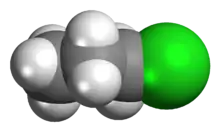n-Propyl chloride
n-Propyl chloride (also 1-propyl chloride or 1-chloropropane) is a colorless, flammable chemical compound. It has the chemical formula C3H7Cl and is prepared by reacting n-propyl alcohol with phosphorus trichloride in the presence of a zinc chloride catalyst.[1]
 | |
| Names | |
|---|---|
| Preferred IUPAC name
1-Chloropropane | |
| Other names
chloromethylethane, propyl chloride, 1-propyl chloride | |
| Identifiers | |
3D model (JSmol) |
|
| ChEMBL | |
| ChemSpider | |
| ECHA InfoCard | 100.007.955 |
| EC Number |
|
PubChem CID |
|
| UNII | |
| UN number | 1278 |
CompTox Dashboard (EPA) |
|
| |
| |
| Properties | |
| C3H7Cl | |
| Molar mass | 78.54 |
| Appearance | Colorless liquid |
| Density | 0.890 |
| Melting point | −122.8 °C (−189.0 °F; 150.3 K) |
| Boiling point | 46.7 °C (116.1 °F; 319.8 K) |
| 0.27 g/100 ml at 20 °C | |
| Solubility in ethanol | miscible |
| Solubility in diethyl ether | miscible |
Refractive index (nD) |
1.3886 |
| Viscosity | 4.416 cP at 0 °C 3.589 cP at 20 °C |
| Hazards | |
| Occupational safety and health (OHS/OSH): | |
Main hazards |
Extremely flammable liquid and vapor. Vapor may cause flash fire. Harmful if swallowed or inhaled. May be harmful if absorbed through skin. Affects central nervous system. Causes irritation to skin, eyes and respiratory tract. |
| GHS labelling: | |
  | |
| Danger | |
| H225, H302, H312, H332 | |
| P210, P233, P240, P241, P242, P243, P261, P264, P270, P271, P280, P301+P312, P302+P352, P303+P361+P353, P304+P312, P304+P340, P312, P322, P330, P363, P370+P378, P403+P235, P501 | |
| NFPA 704 (fire diamond) | |
| Flash point | −18 °C (0 °F; 255 K) |
| Safety data sheet (SDS) | External MSDS |
| Related compounds | |
Related alkyl halides |
Ethyl chloride isopropyl chloride Tert-Butyl chloride |
Except where otherwise noted, data are given for materials in their standard state (at 25 °C [77 °F], 100 kPa).
Infobox references | |
Properties
1-chloropropane is the simplest asymmetric chloropropane, analogous to the symmetric 2-chloropropane. Because of the presence of the heavy electronegative chlorine atom, 1-chloropropane has a higher melting point and boiling point than propane (BP 46.6 °C vs -42 °C).
References
- Merck Index of Chemicals and Drugs, 9th ed., monograph 7635
This article is issued from Wikipedia. The text is licensed under Creative Commons - Attribution - Sharealike. Additional terms may apply for the media files.
